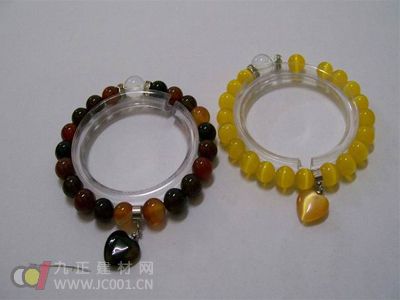What are the varieties of Dushan jade?
Dushan jade is known for its rich and diverse color palette, which results from the presence of various minerals and trace elements. This multi-colored gemstone can be classified into eight distinct types based on color. More than 50% of Dushan jade is variegated, while about 30% is green, and 10% is white. The colors vary depending on the elements present: chromium gives a green or emerald-green hue, vanadium produces yellow tones, iron, manganese, and copper create reddish shades, and other elements like titanium, nickel, cobalt, zinc, and tin contribute to purple, brown, and more complex combinations.
1. Green Dushan Jade
This variety ranges from vibrant emerald green to lighter shades like gray-green, blue-green, and yellow-green. It often contains white areas and features irregular banding, filaments, or clusters. Known for its fine texture and glassy luster, it can be transparent to translucent. The most prized type is the clear blue-green variety, also called "Tianlan jade" or "Nanyang Cuiyu." However, high-quality specimens have become rarer in recent years, with many pieces now being gray-green and opaque.

2. Red Dushan Jade
Also known as "Furong jade," this type displays pink or hibiscus-like hues in various shades. It is typically semi-transparent to opaque, with a fine texture and smooth surface. It often has a transitional relationship with white jade, though it is relatively rare, making up less than 5% of Dushan jade.
3. White Dushan Jade
This variety appears in milky white or pure white tones, with a fine, oily luster and varying levels of transparency. It can be categorized into three types: water white (most desirable), oil white, and dry white. Water white is considered the highest quality, and white jade accounts for approximately 10% of all Dushan jade.
4. Purple Dushan Jade
It exhibits deep purple tones and has a fine, dense texture with a glassy sheen. Though not very transparent, it is commonly referred to as "bright brown jade," "sauce purple jade," or "purple jade."
5. Yellow Dushan Jade
This variety comes in different shades of yellow or brownish-yellow. It is usually semi-transparent and often contains white or brown patches, with soft transitional color changes.
6. Black Dushan Jade
Known as "Moyu" or "ink jade," this type has a dark, ink-like appearance. It is generally opaque with coarser grains and may contain white areas. It is considered the least valuable among Dushan jade varieties.
7. Blue Dushan Jade
It shows shades of cyan, gray-blue, or blue-green, often appearing in blocks or bands. It is usually opaque and is one of the more common types of Dushan jade.
8. Variegated Dushan Jade
This is the most common type, making up over 50% of Dushan jade reserves. It features two or more colors within a single piece, sometimes even four or five different hues in large raw materials or carvings. Colors such as green, white, brown, and black may appear together in a dip-like or gradual transition. Even small pieces, like those less than 1 cm in size, can display multiple colors. This complex color variation plays a key role in identifying genuine Dushan jade.
In terms of quality, the best Dushan jade is characterized by vivid, pure colors, high transparency, fine texture, and no impurities or cracks. Varieties like hibiscus stone, permeable white jade, and green jade are particularly valuable. Additionally, artisans often use differently colored jade blocks to create intricate carvings that mimic natural patterns, which are highly appreciated in the market.
Led Outdoor Wall Light,Modern Outdoor Wall Lighting,Led Outdoor Light,Led Outdoor Lamp
Ningbo Royalux Lighting Co., Ltd. , https://www.royaluxlite.com